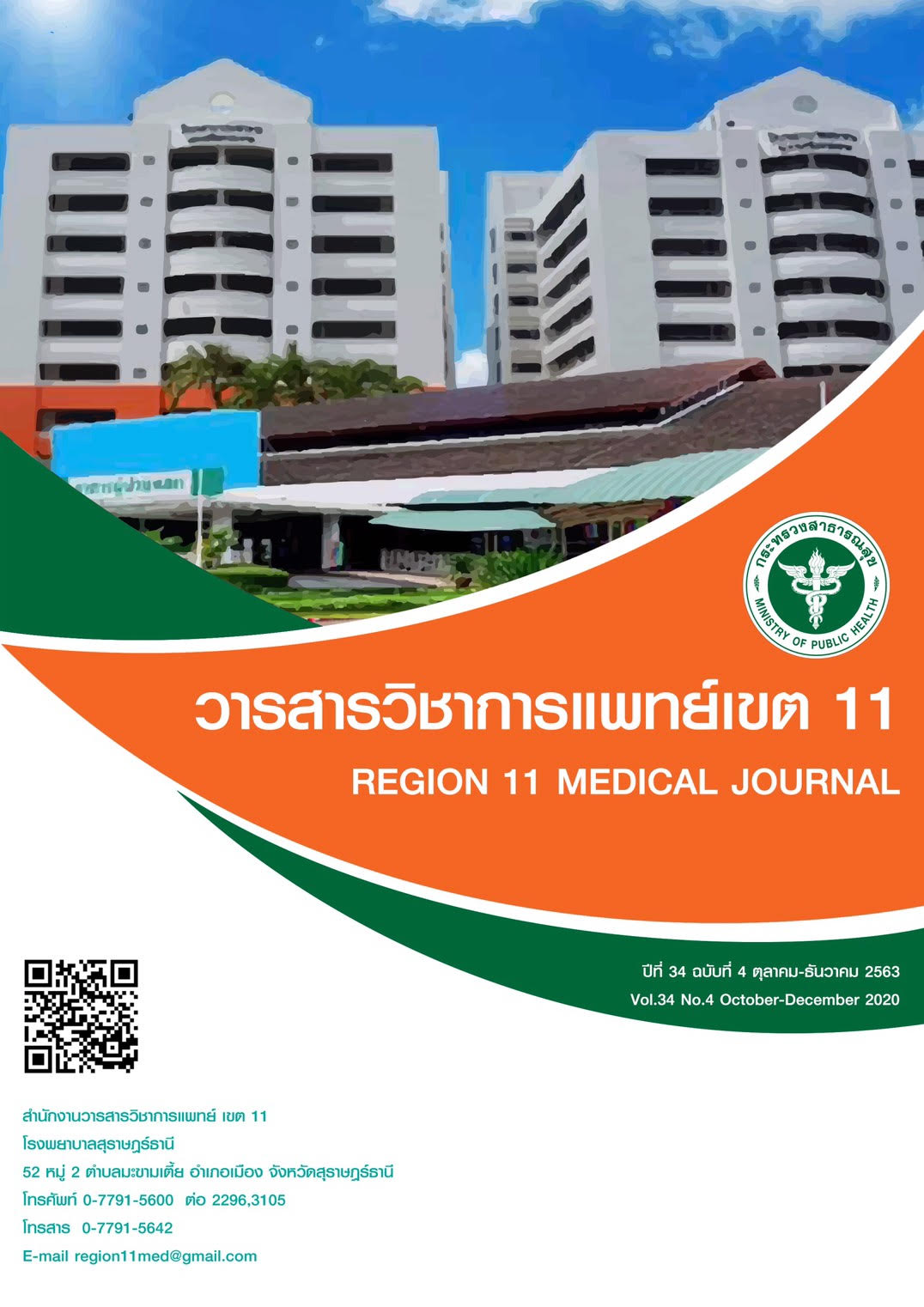Study reject digital radiographic in digital radiography system at Surat Thani Hospital
Keywords:
digital radiography, picture archiving and communication systemAbstract
Background: The technology of radiography has been transformed into digital systems. There is a substitute for film-screen systems, resulting in better quality radiographic images. However, reject digital radiographic was still a problem in the development of radiology quality systems.
Objectives: To analyze the causes of digital radiographic and guideline for reduce reject rate of digital radiographic of the radiology department. Surat Thani Hospital
Method: This study was a retrospective study of the PACS and reject digital radiographic on DR system in four x-ray room between December 2019 and May 2020. Collecting data to calculate, record data, inspect, and process statistics presenting the data in the form of frequency tables, percentage, means by means of statistical package software.
Results: Reject rate of digital radiographic 3,786 images (6.4%), caused by positioning 2,379 images (62.9%), artifact 380 images (10.0%), grid cut off 281 images (7.4%), patient movement 274 images (7.2%), under exposed 77 images (2.0%), test/QC 41 images (1.1%), and over exposed 39 images (1.0%), respectively. Classified by organ, including chest 1,249 images (33.0%), lower extremities 843 images (22.3%), abdomen/KUB 496 images (13.1%), upper extremities 485 images (12.8%), spine 432 images (11.4%), and skull/facial bone 281 images (7.4%), respectively.
Conclusion: The studies have shown that thorax radiographic were the most reject digital radiographic caused by reject of reasons of DR system although it has higher detail and image quality. Radiographic can be customized post-processing does not reduce the cause of digital radiographic from positioning reduce the amount of reject digital radiographic eliminated. The technologist must change the concepts attitudes and procedures and regularly reviewing knowledge in order to get quality digital radiographic and reduce the repeated x-ray to minimum.
References
ลัดดา เย็นศรี.การศึกษาเปรียบเทียบปริมาณรังสีที่ผู้ป่วยได้รับจากการถ่ายภาพรังสีทรวงอกด้วยระบบ CR และ DR โรงพยาบาลสงขลา.วารสารเครือข่ายวิทยาลัยและการสาธารณสุขภาคใต้. 2559;3(1):29-39.
เพชรากร หาญพานิชย์ และวัลลภ เหล่าไพบูลย์. ระบบสื่อสารและการเก็บข้อมูลภาพทางการแพทย์ [อินเทอร์เน็ต]. 2550 [เข้าถึงเมื่อ 20 มิถุนายน 2563]. เข้าถึงได้จาก http://smj.ejnal.com/e-journal/showdetail/?show_detail=T&art_id=1339.
นิพนธ์ จันทร์ลำภู.การตั้งค่าเทคนิคให้ปริมาณรังสีที่เหมาะสมสำหรับการสร้างภาพรังสีระบบดิจิตอลในหุ่นจำลอง. วารสารโรงพยาบาลธรรมศาสตร์เฉลิมพระเกียรติ. 2019;4(1):14-30.
อนงค์ สิงกาวงไซย์, ศิริวรรณ บุญชรัตน์, สุภาคี สยุมภูรุจินันท์, นัฐิกา จิตรพินิจ. คู่มือการตรวจประเมินมาตรฐานห้องปฏิบัติการรังสีวินิจฉัย กระทรวงสาธารณสุข. กรุงเทพฯ: สำนักมาตรฐานห้องปฏิบัติการ กรมวิทยาศาสตร์การแพทย์; 2562.
สมหมาย กันทะเมืองลี้. การวิเคราะห์ภาพดิจิตอลทางรังสีที่ไม่สามารถนำไปวินิจฉัยโรคได้ โรงพยาบาลนครปฐม. วารสารสุขภาพภาคประชาชน 2560;12(4):28-35.
พัทธนันท์ คงทอง, ปัญญา โรจนวรรณ. ฟิล์มเสียจาการถ่ายภาพรังสีวินิจฉัย โรงพยาบาลศูนย์ตรัง. วารสารวิจัยสาธารณสุขศาสตร์ มหาวิทยาลัยขอนแก่น. 2555;5(2):21-28.
Yurt A, ustafa Tintas M, Yüksel R. Reject Analysis in Digital Radiography: A Prospective Study. International Journal of Anatomy Radiography and Surgery. 2018;7(4):27-29.
Lin C-S, Chan P-C, Huang K-H, Lu C-F, Chen Y-F, Lin Chen Y-O. Guidelines for reducing image retakes of general digital radiography. Advances in Mechanical Engineering. 2016;8(4):1-6.
Eric A Berns, Douglas E Pfeiffer, Priscilla f Butler. Digital Mammography Quality control manual. American College of Radiology 2018:75-77.
Lloyd PJ. Quality assurance workbook for radiographers and radiological technologists: World Health Organization; 2001:19-24.






